ECON6000 Economic Principles: Decision Making on Demand & Tariffs
VerifiedAdded on 2023/05/29
|8
|1421
|369
Report
AI Summary
This report analyzes the demand for energy bars using regression analysis, focusing on the impact of average income, tariff rates, and the number of stores offering the product. The analysis reveals that income and the number of stores positively influence demand, while tariffs have a negative impact. The report further explores the effects of tariffs on imported goods, demonstrating how they increase prices and reduce demand, ultimately leading to a welfare loss. Finally, it advocates for free trade agreements, highlighting their potential to lower costs, increase consumer benefits, and expand business opportunities, using the example of energy bar exchange between Atolia and Industria. Desklib provides comprehensive study tools and resources for similar assignments.
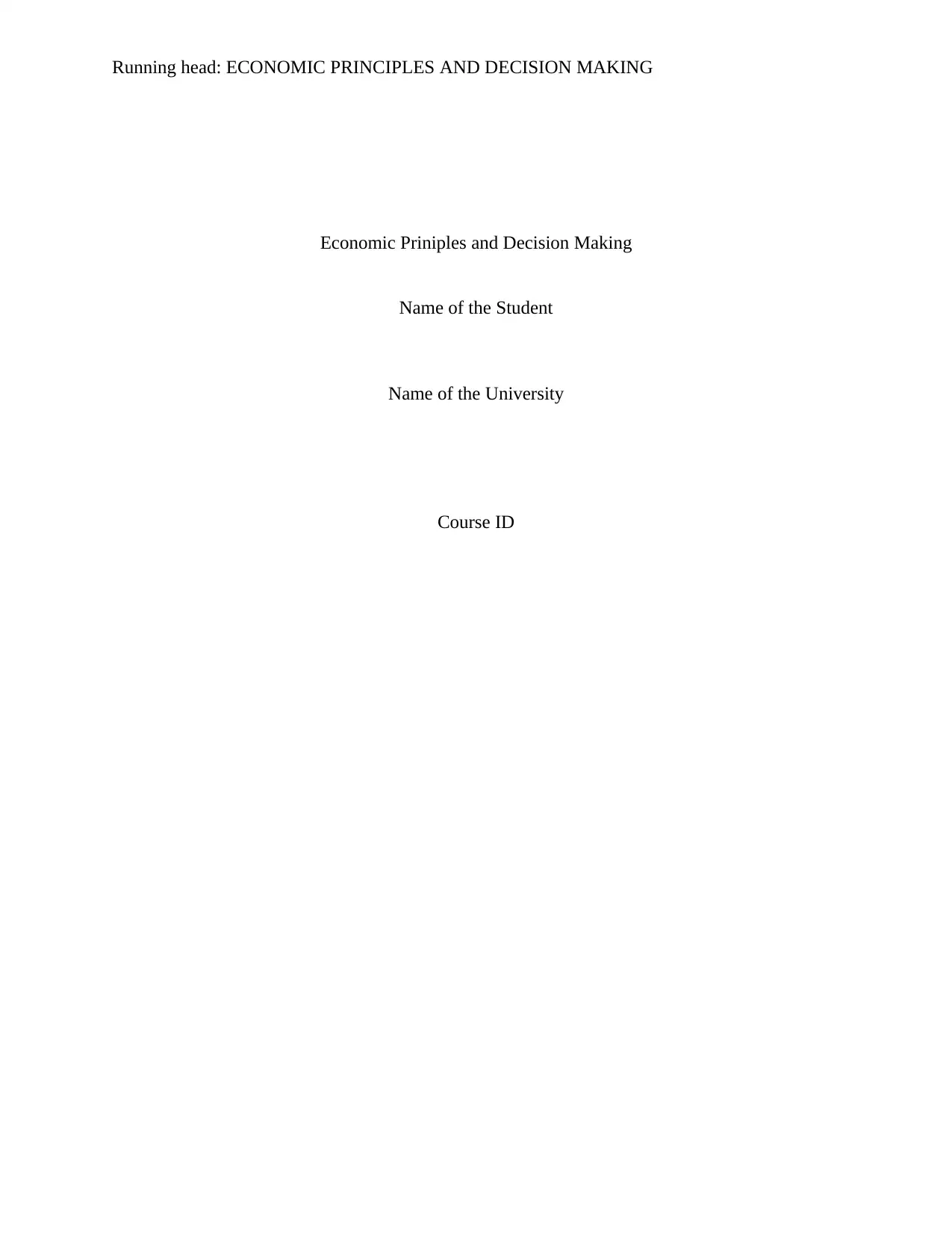
Running head: ECONOMIC PRINCIPLES AND DECISION MAKING
Economic Priniples and Decision Making
Name of the Student
Name of the University
Course ID
Economic Priniples and Decision Making
Name of the Student
Name of the University
Course ID
Paraphrase This Document
Need a fresh take? Get an instant paraphrase of this document with our AI Paraphraser
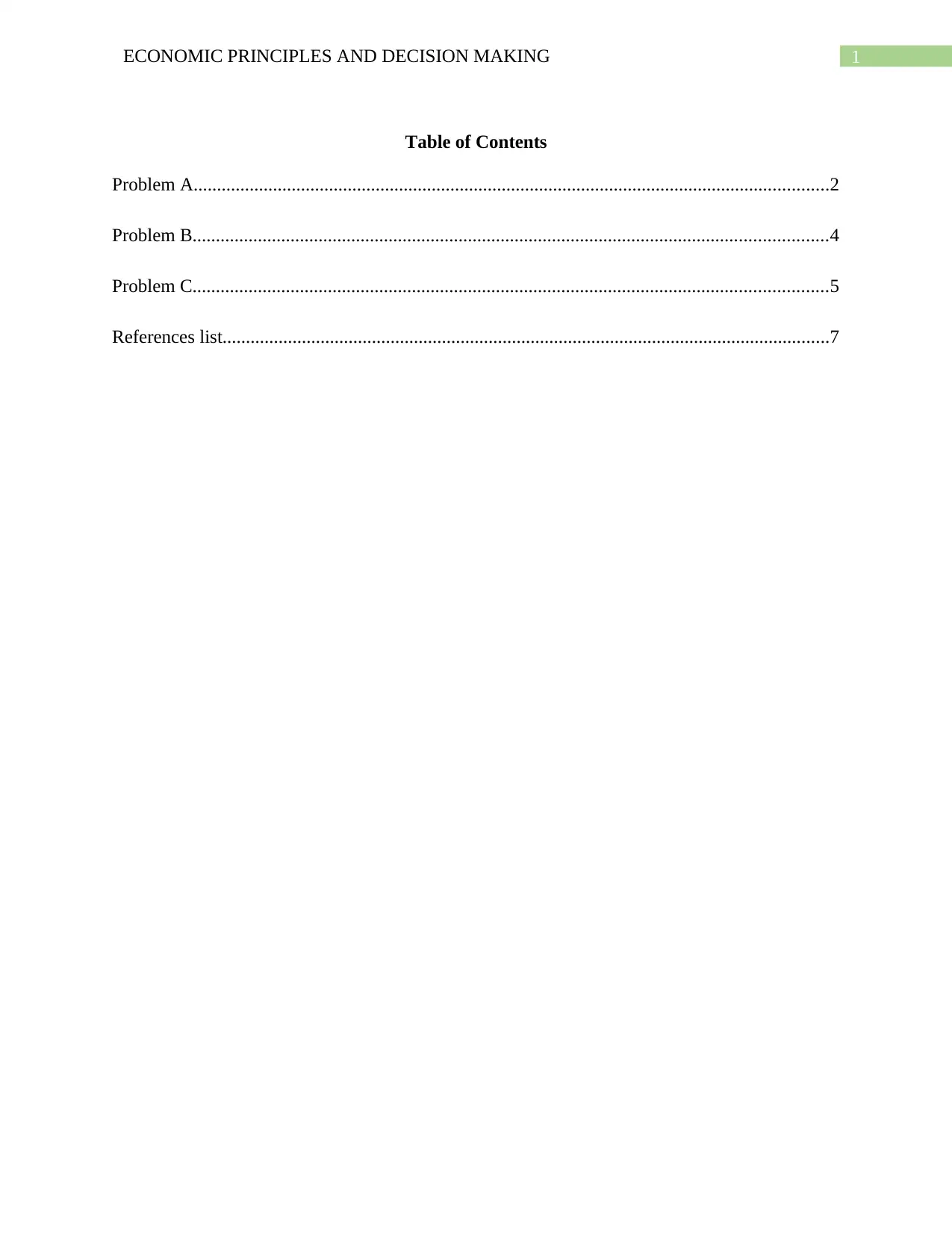
1ECONOMIC PRINCIPLES AND DECISION MAKING
Table of Contents
Problem A........................................................................................................................................2
Problem B........................................................................................................................................4
Problem C........................................................................................................................................5
References list..................................................................................................................................7
Table of Contents
Problem A........................................................................................................................................2
Problem B........................................................................................................................................4
Problem C........................................................................................................................................5
References list..................................................................................................................................7
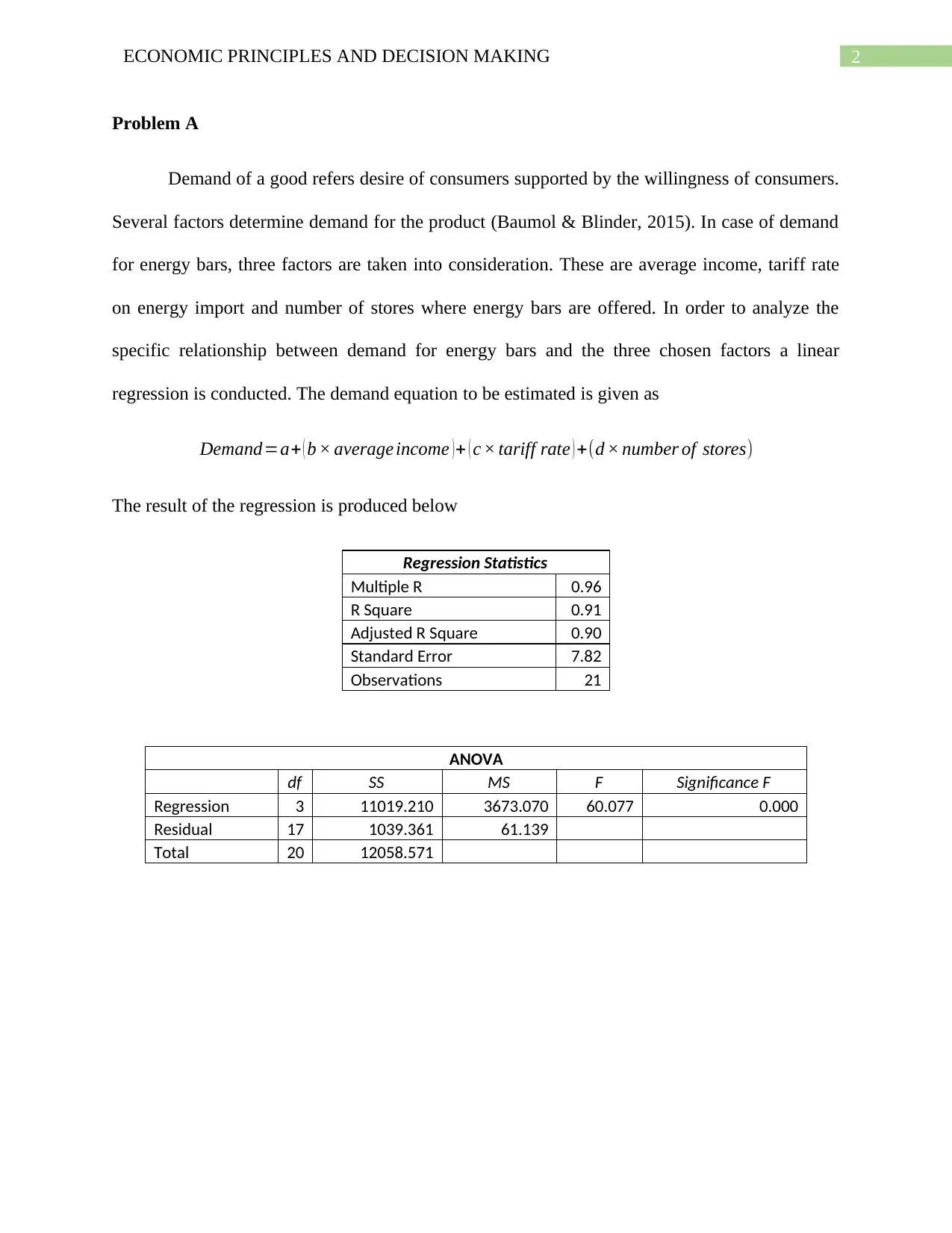
2ECONOMIC PRINCIPLES AND DECISION MAKING
Problem A
Demand of a good refers desire of consumers supported by the willingness of consumers.
Several factors determine demand for the product (Baumol & Blinder, 2015). In case of demand
for energy bars, three factors are taken into consideration. These are average income, tariff rate
on energy import and number of stores where energy bars are offered. In order to analyze the
specific relationship between demand for energy bars and the three chosen factors a linear
regression is conducted. The demand equation to be estimated is given as
Demand=a+ ( b × average income ) + ( c × tariff rate ) +(d × number of stores)
The result of the regression is produced below
Regression Statistics
Multiple R 0.96
R Square 0.91
Adjusted R Square 0.90
Standard Error 7.82
Observations 21
ANOVA
df SS MS F Significance F
Regression 3 11019.210 3673.070 60.077 0.000
Residual 17 1039.361 61.139
Total 20 12058.571
Problem A
Demand of a good refers desire of consumers supported by the willingness of consumers.
Several factors determine demand for the product (Baumol & Blinder, 2015). In case of demand
for energy bars, three factors are taken into consideration. These are average income, tariff rate
on energy import and number of stores where energy bars are offered. In order to analyze the
specific relationship between demand for energy bars and the three chosen factors a linear
regression is conducted. The demand equation to be estimated is given as
Demand=a+ ( b × average income ) + ( c × tariff rate ) +(d × number of stores)
The result of the regression is produced below
Regression Statistics
Multiple R 0.96
R Square 0.91
Adjusted R Square 0.90
Standard Error 7.82
Observations 21
ANOVA
df SS MS F Significance F
Regression 3 11019.210 3673.070 60.077 0.000
Residual 17 1039.361 61.139
Total 20 12058.571
⊘ This is a preview!⊘
Do you want full access?
Subscribe today to unlock all pages.

Trusted by 1+ million students worldwide
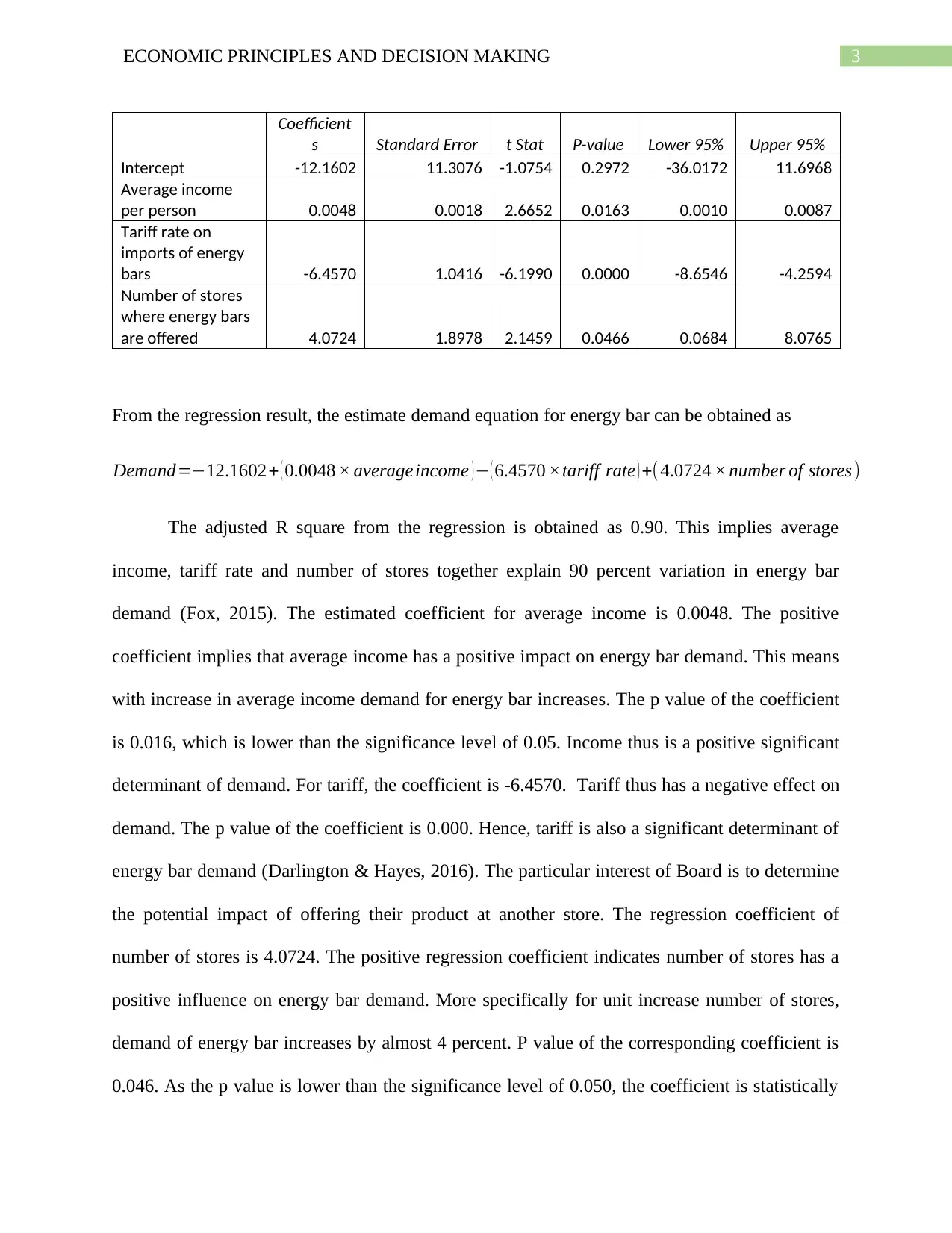
3ECONOMIC PRINCIPLES AND DECISION MAKING
Coefficient
s Standard Error t Stat P-value Lower 95% Upper 95%
Intercept -12.1602 11.3076 -1.0754 0.2972 -36.0172 11.6968
Average income
per person 0.0048 0.0018 2.6652 0.0163 0.0010 0.0087
Tariff rate on
imports of energy
bars -6.4570 1.0416 -6.1990 0.0000 -8.6546 -4.2594
Number of stores
where energy bars
are offered 4.0724 1.8978 2.1459 0.0466 0.0684 8.0765
From the regression result, the estimate demand equation for energy bar can be obtained as
Demand=−12.1602+ ( 0.0048 × average income ) − ( 6.4570 ×tariff rate ) +( 4.0724 × number of stores)
The adjusted R square from the regression is obtained as 0.90. This implies average
income, tariff rate and number of stores together explain 90 percent variation in energy bar
demand (Fox, 2015). The estimated coefficient for average income is 0.0048. The positive
coefficient implies that average income has a positive impact on energy bar demand. This means
with increase in average income demand for energy bar increases. The p value of the coefficient
is 0.016, which is lower than the significance level of 0.05. Income thus is a positive significant
determinant of demand. For tariff, the coefficient is -6.4570. Tariff thus has a negative effect on
demand. The p value of the coefficient is 0.000. Hence, tariff is also a significant determinant of
energy bar demand (Darlington & Hayes, 2016). The particular interest of Board is to determine
the potential impact of offering their product at another store. The regression coefficient of
number of stores is 4.0724. The positive regression coefficient indicates number of stores has a
positive influence on energy bar demand. More specifically for unit increase number of stores,
demand of energy bar increases by almost 4 percent. P value of the corresponding coefficient is
0.046. As the p value is lower than the significance level of 0.050, the coefficient is statistically
Coefficient
s Standard Error t Stat P-value Lower 95% Upper 95%
Intercept -12.1602 11.3076 -1.0754 0.2972 -36.0172 11.6968
Average income
per person 0.0048 0.0018 2.6652 0.0163 0.0010 0.0087
Tariff rate on
imports of energy
bars -6.4570 1.0416 -6.1990 0.0000 -8.6546 -4.2594
Number of stores
where energy bars
are offered 4.0724 1.8978 2.1459 0.0466 0.0684 8.0765
From the regression result, the estimate demand equation for energy bar can be obtained as
Demand=−12.1602+ ( 0.0048 × average income ) − ( 6.4570 ×tariff rate ) +( 4.0724 × number of stores)
The adjusted R square from the regression is obtained as 0.90. This implies average
income, tariff rate and number of stores together explain 90 percent variation in energy bar
demand (Fox, 2015). The estimated coefficient for average income is 0.0048. The positive
coefficient implies that average income has a positive impact on energy bar demand. This means
with increase in average income demand for energy bar increases. The p value of the coefficient
is 0.016, which is lower than the significance level of 0.05. Income thus is a positive significant
determinant of demand. For tariff, the coefficient is -6.4570. Tariff thus has a negative effect on
demand. The p value of the coefficient is 0.000. Hence, tariff is also a significant determinant of
energy bar demand (Darlington & Hayes, 2016). The particular interest of Board is to determine
the potential impact of offering their product at another store. The regression coefficient of
number of stores is 4.0724. The positive regression coefficient indicates number of stores has a
positive influence on energy bar demand. More specifically for unit increase number of stores,
demand of energy bar increases by almost 4 percent. P value of the corresponding coefficient is
0.046. As the p value is lower than the significance level of 0.050, the coefficient is statistically
Paraphrase This Document
Need a fresh take? Get an instant paraphrase of this document with our AI Paraphraser
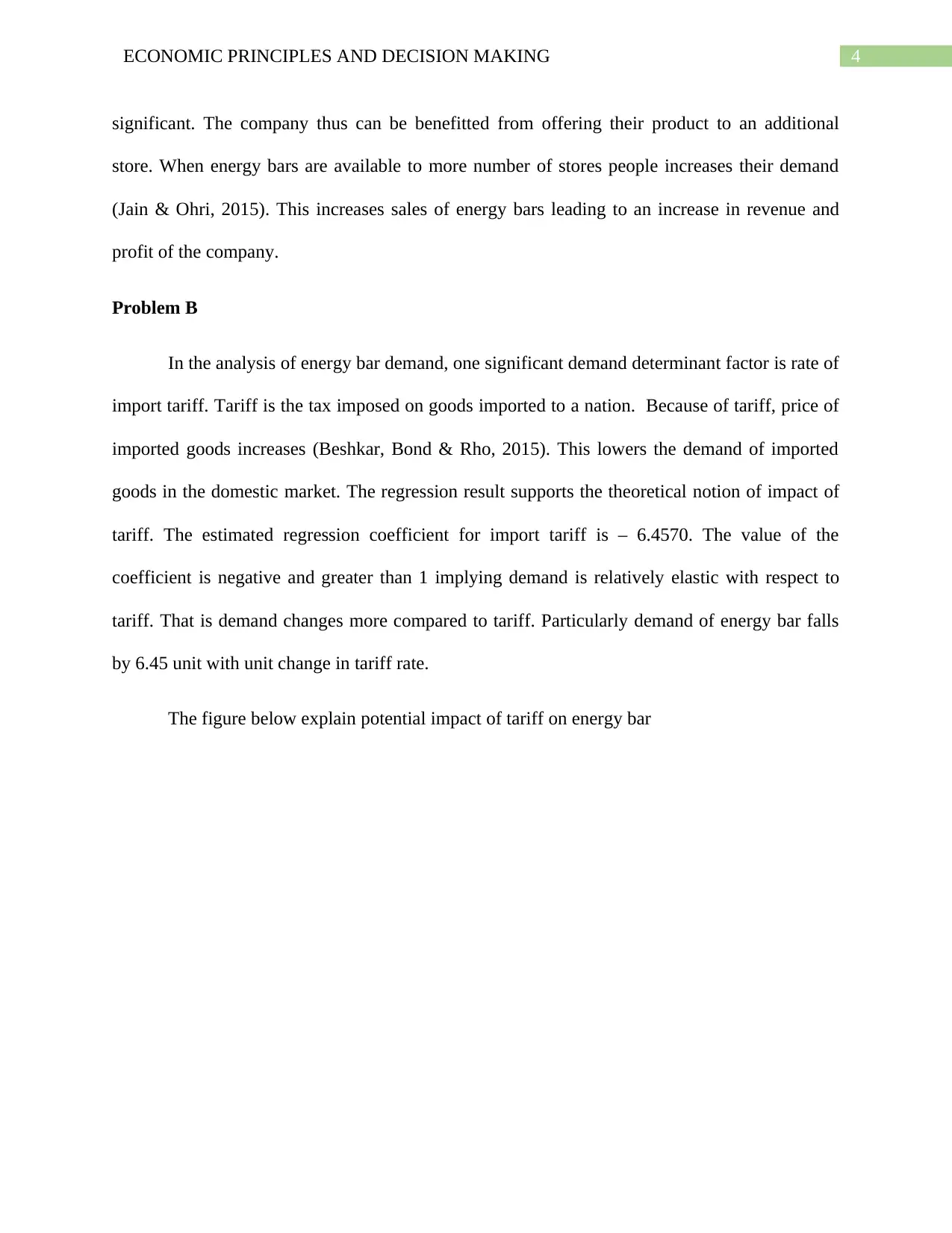
4ECONOMIC PRINCIPLES AND DECISION MAKING
significant. The company thus can be benefitted from offering their product to an additional
store. When energy bars are available to more number of stores people increases their demand
(Jain & Ohri, 2015). This increases sales of energy bars leading to an increase in revenue and
profit of the company.
Problem B
In the analysis of energy bar demand, one significant demand determinant factor is rate of
import tariff. Tariff is the tax imposed on goods imported to a nation. Because of tariff, price of
imported goods increases (Beshkar, Bond & Rho, 2015). This lowers the demand of imported
goods in the domestic market. The regression result supports the theoretical notion of impact of
tariff. The estimated regression coefficient for import tariff is – 6.4570. The value of the
coefficient is negative and greater than 1 implying demand is relatively elastic with respect to
tariff. That is demand changes more compared to tariff. Particularly demand of energy bar falls
by 6.45 unit with unit change in tariff rate.
The figure below explain potential impact of tariff on energy bar
significant. The company thus can be benefitted from offering their product to an additional
store. When energy bars are available to more number of stores people increases their demand
(Jain & Ohri, 2015). This increases sales of energy bars leading to an increase in revenue and
profit of the company.
Problem B
In the analysis of energy bar demand, one significant demand determinant factor is rate of
import tariff. Tariff is the tax imposed on goods imported to a nation. Because of tariff, price of
imported goods increases (Beshkar, Bond & Rho, 2015). This lowers the demand of imported
goods in the domestic market. The regression result supports the theoretical notion of impact of
tariff. The estimated regression coefficient for import tariff is – 6.4570. The value of the
coefficient is negative and greater than 1 implying demand is relatively elastic with respect to
tariff. That is demand changes more compared to tariff. Particularly demand of energy bar falls
by 6.45 unit with unit change in tariff rate.
The figure below explain potential impact of tariff on energy bar
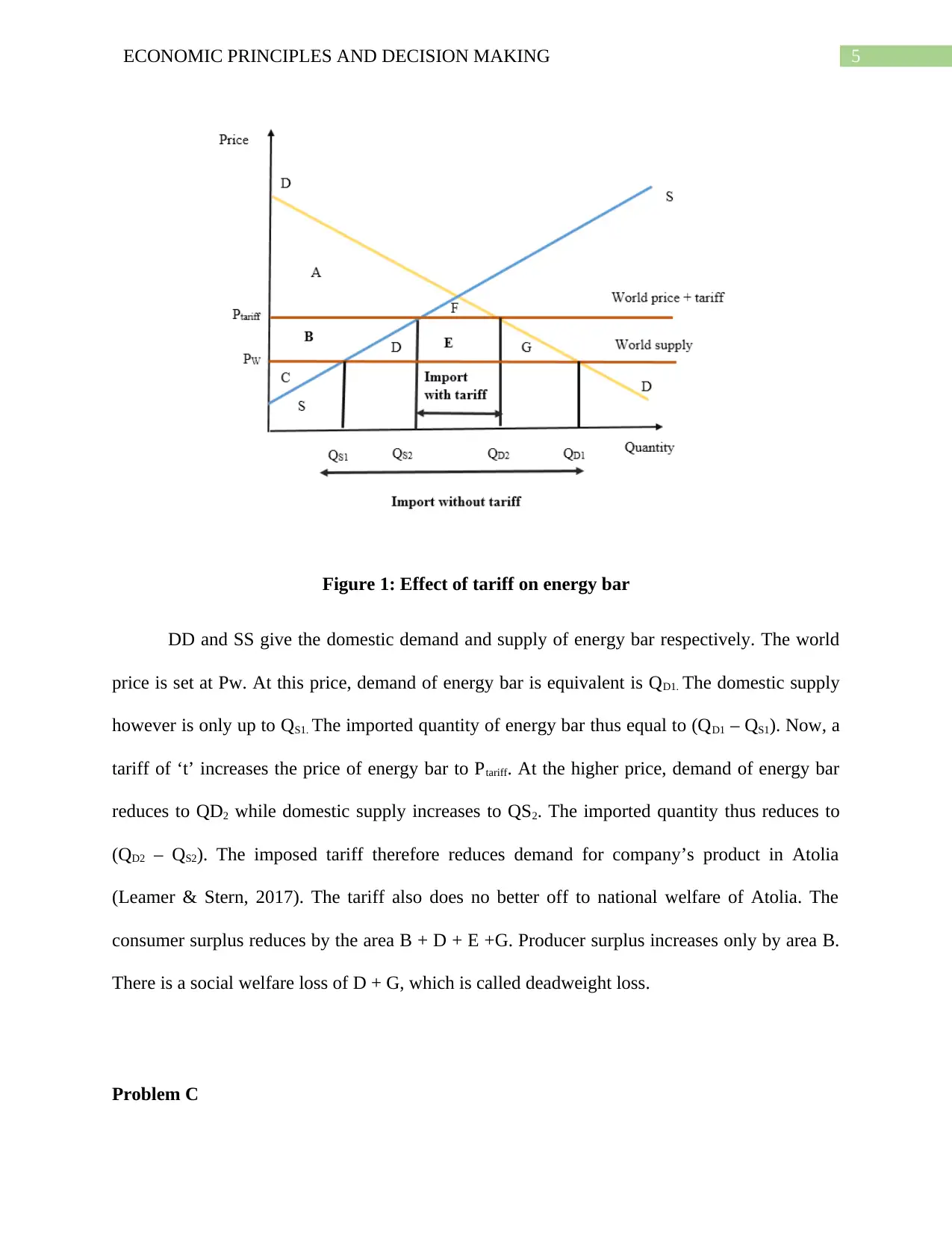
5ECONOMIC PRINCIPLES AND DECISION MAKING
Figure 1: Effect of tariff on energy bar
DD and SS give the domestic demand and supply of energy bar respectively. The world
price is set at Pw. At this price, demand of energy bar is equivalent is QD1. The domestic supply
however is only up to QS1. The imported quantity of energy bar thus equal to (QD1 – QS1). Now, a
tariff of ‘t’ increases the price of energy bar to Ptariff. At the higher price, demand of energy bar
reduces to QD2 while domestic supply increases to QS2. The imported quantity thus reduces to
(QD2 – QS2). The imposed tariff therefore reduces demand for company’s product in Atolia
(Leamer & Stern, 2017). The tariff also does no better off to national welfare of Atolia. The
consumer surplus reduces by the area B + D + E +G. Producer surplus increases only by area B.
There is a social welfare loss of D + G, which is called deadweight loss.
Problem C
Figure 1: Effect of tariff on energy bar
DD and SS give the domestic demand and supply of energy bar respectively. The world
price is set at Pw. At this price, demand of energy bar is equivalent is QD1. The domestic supply
however is only up to QS1. The imported quantity of energy bar thus equal to (QD1 – QS1). Now, a
tariff of ‘t’ increases the price of energy bar to Ptariff. At the higher price, demand of energy bar
reduces to QD2 while domestic supply increases to QS2. The imported quantity thus reduces to
(QD2 – QS2). The imposed tariff therefore reduces demand for company’s product in Atolia
(Leamer & Stern, 2017). The tariff also does no better off to national welfare of Atolia. The
consumer surplus reduces by the area B + D + E +G. Producer surplus increases only by area B.
There is a social welfare loss of D + G, which is called deadweight loss.
Problem C
⊘ This is a preview!⊘
Do you want full access?
Subscribe today to unlock all pages.

Trusted by 1+ million students worldwide
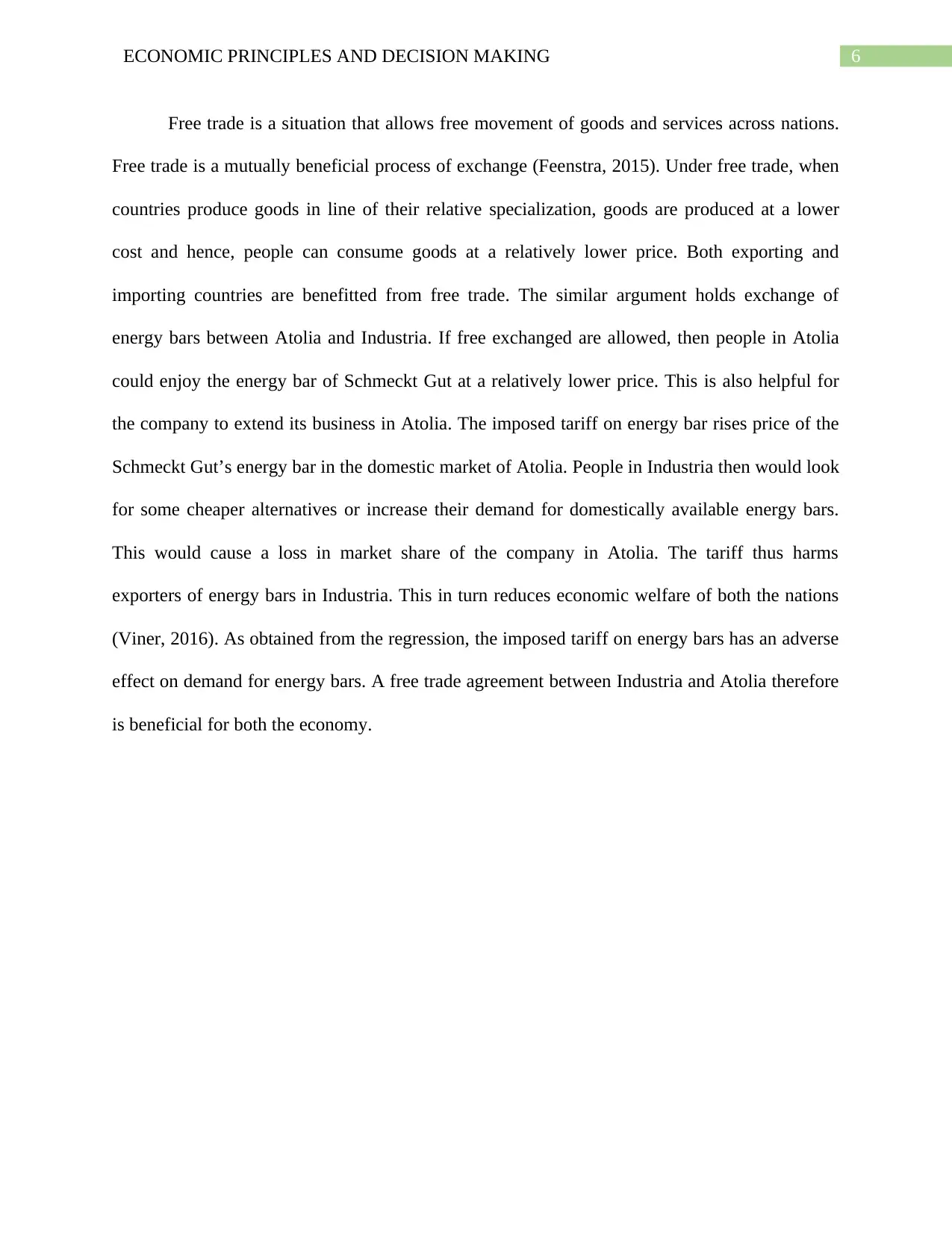
6ECONOMIC PRINCIPLES AND DECISION MAKING
Free trade is a situation that allows free movement of goods and services across nations.
Free trade is a mutually beneficial process of exchange (Feenstra, 2015). Under free trade, when
countries produce goods in line of their relative specialization, goods are produced at a lower
cost and hence, people can consume goods at a relatively lower price. Both exporting and
importing countries are benefitted from free trade. The similar argument holds exchange of
energy bars between Atolia and Industria. If free exchanged are allowed, then people in Atolia
could enjoy the energy bar of Schmeckt Gut at a relatively lower price. This is also helpful for
the company to extend its business in Atolia. The imposed tariff on energy bar rises price of the
Schmeckt Gut’s energy bar in the domestic market of Atolia. People in Industria then would look
for some cheaper alternatives or increase their demand for domestically available energy bars.
This would cause a loss in market share of the company in Atolia. The tariff thus harms
exporters of energy bars in Industria. This in turn reduces economic welfare of both the nations
(Viner, 2016). As obtained from the regression, the imposed tariff on energy bars has an adverse
effect on demand for energy bars. A free trade agreement between Industria and Atolia therefore
is beneficial for both the economy.
Free trade is a situation that allows free movement of goods and services across nations.
Free trade is a mutually beneficial process of exchange (Feenstra, 2015). Under free trade, when
countries produce goods in line of their relative specialization, goods are produced at a lower
cost and hence, people can consume goods at a relatively lower price. Both exporting and
importing countries are benefitted from free trade. The similar argument holds exchange of
energy bars between Atolia and Industria. If free exchanged are allowed, then people in Atolia
could enjoy the energy bar of Schmeckt Gut at a relatively lower price. This is also helpful for
the company to extend its business in Atolia. The imposed tariff on energy bar rises price of the
Schmeckt Gut’s energy bar in the domestic market of Atolia. People in Industria then would look
for some cheaper alternatives or increase their demand for domestically available energy bars.
This would cause a loss in market share of the company in Atolia. The tariff thus harms
exporters of energy bars in Industria. This in turn reduces economic welfare of both the nations
(Viner, 2016). As obtained from the regression, the imposed tariff on energy bars has an adverse
effect on demand for energy bars. A free trade agreement between Industria and Atolia therefore
is beneficial for both the economy.
Paraphrase This Document
Need a fresh take? Get an instant paraphrase of this document with our AI Paraphraser
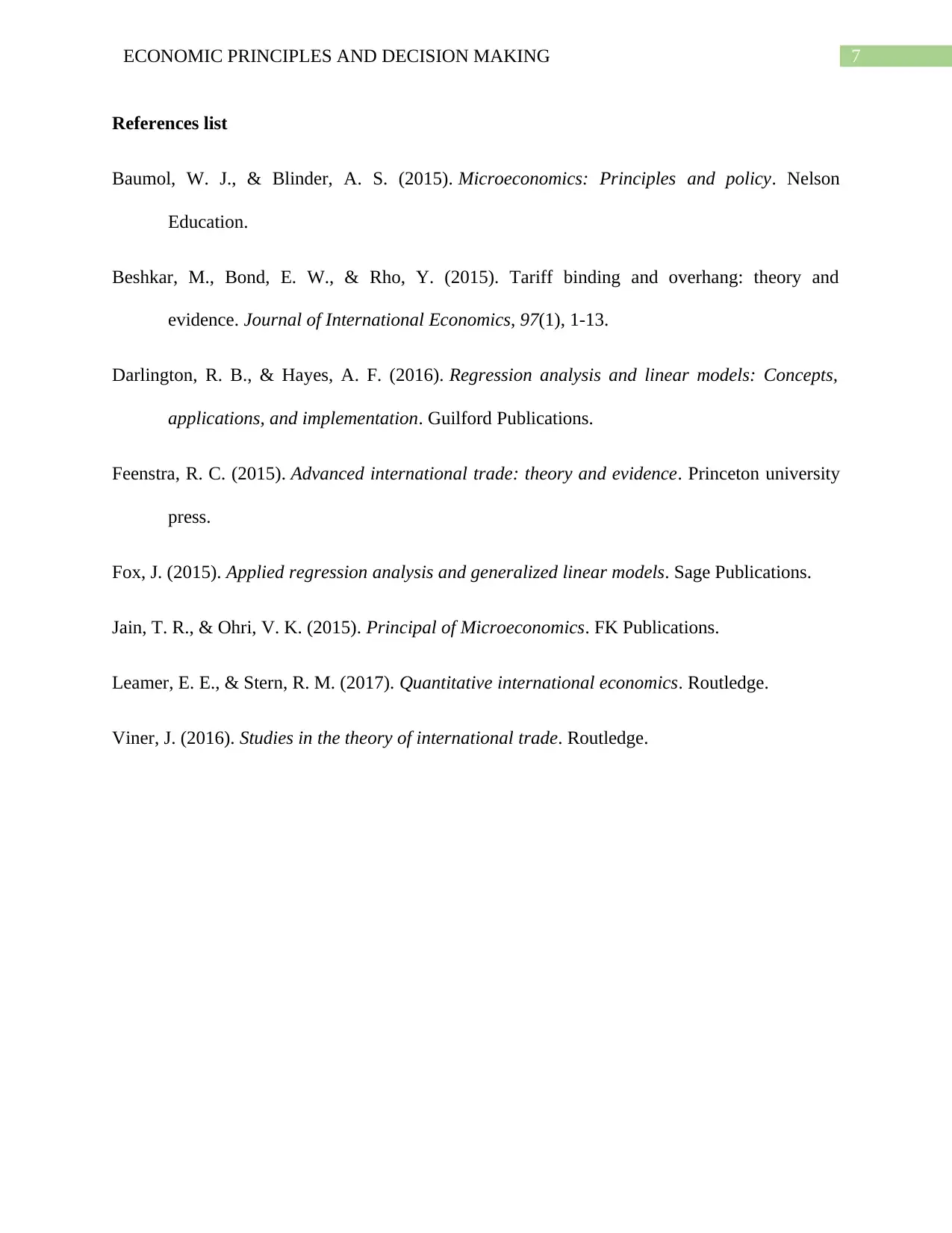
7ECONOMIC PRINCIPLES AND DECISION MAKING
References list
Baumol, W. J., & Blinder, A. S. (2015). Microeconomics: Principles and policy. Nelson
Education.
Beshkar, M., Bond, E. W., & Rho, Y. (2015). Tariff binding and overhang: theory and
evidence. Journal of International Economics, 97(1), 1-13.
Darlington, R. B., & Hayes, A. F. (2016). Regression analysis and linear models: Concepts,
applications, and implementation. Guilford Publications.
Feenstra, R. C. (2015). Advanced international trade: theory and evidence. Princeton university
press.
Fox, J. (2015). Applied regression analysis and generalized linear models. Sage Publications.
Jain, T. R., & Ohri, V. K. (2015). Principal of Microeconomics. FK Publications.
Leamer, E. E., & Stern, R. M. (2017). Quantitative international economics. Routledge.
Viner, J. (2016). Studies in the theory of international trade. Routledge.
References list
Baumol, W. J., & Blinder, A. S. (2015). Microeconomics: Principles and policy. Nelson
Education.
Beshkar, M., Bond, E. W., & Rho, Y. (2015). Tariff binding and overhang: theory and
evidence. Journal of International Economics, 97(1), 1-13.
Darlington, R. B., & Hayes, A. F. (2016). Regression analysis and linear models: Concepts,
applications, and implementation. Guilford Publications.
Feenstra, R. C. (2015). Advanced international trade: theory and evidence. Princeton university
press.
Fox, J. (2015). Applied regression analysis and generalized linear models. Sage Publications.
Jain, T. R., & Ohri, V. K. (2015). Principal of Microeconomics. FK Publications.
Leamer, E. E., & Stern, R. M. (2017). Quantitative international economics. Routledge.
Viner, J. (2016). Studies in the theory of international trade. Routledge.
1 out of 8
Related Documents
Your All-in-One AI-Powered Toolkit for Academic Success.
+13062052269
info@desklib.com
Available 24*7 on WhatsApp / Email
![[object Object]](/_next/static/media/star-bottom.7253800d.svg)
Unlock your academic potential
Copyright © 2020–2025 A2Z Services. All Rights Reserved. Developed and managed by ZUCOL.




